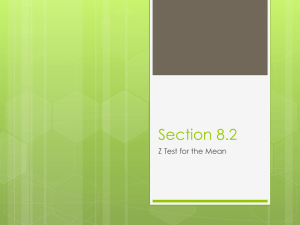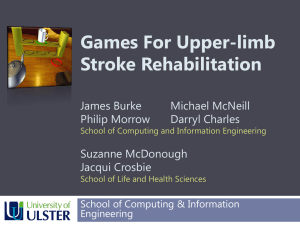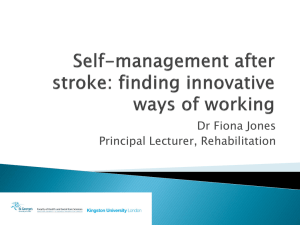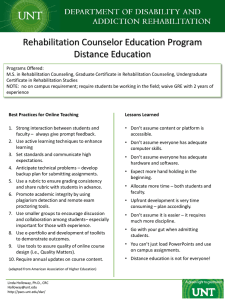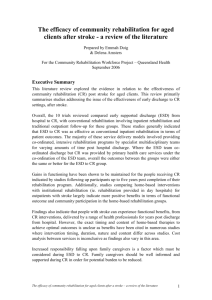Embedded Arts for Movement Retraining
advertisement
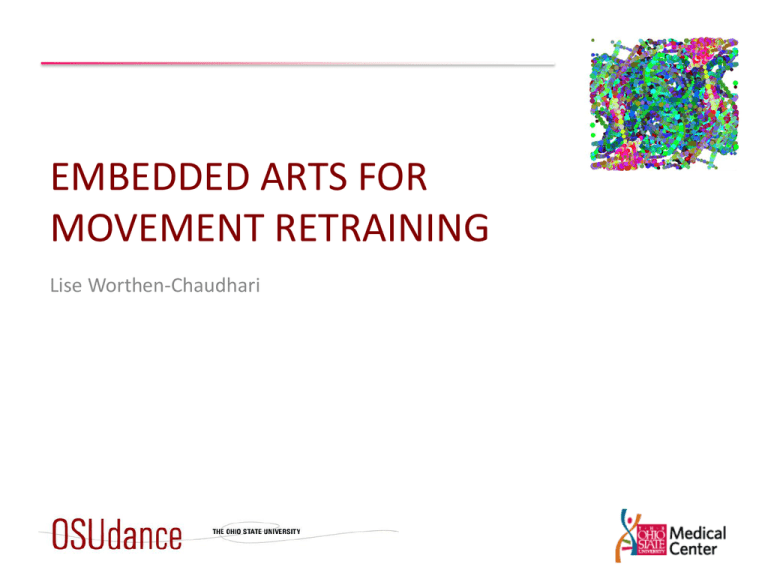
EMBEDDED ARTS FOR MOVEMENT RETRAINING Lise Worthen-Chaudhari Description Embedded Arts is an interactive computer program designed as a rehabilitation biofeedback tool. The purpose of the system is to tap into artistic and creative neural pathways during performance of standard rehabilitation exercises. Using real-time data from biophysical sensors, the program integrates creative process within rehabilitation protocols by translating movement into art. Therapy and Neurorehab “This ability of our neural wiring to reroute when given the right stimuli can be a powerful agent for recovery and has, since the 1980s, emerged as the most promising phenomenon for facilitating neurorehabilitation.” Nudo & Dancause (2007) in Brain Injury Medicine: Principles and Practices http://www.youtube.com/watch?v=MABD7sYplkk Purpose • enable patients to create fun, individualized images that would be aesthetically and kinesthetically satisfying, but that would also represent a patient's personal healing through the process of activity-based medicine. Hypothesis • Embedding interactive arts processes within rehabilitation exercises may improve outcomes – Increasing gains in physical tacit knowledge construction – Improving patient attention and compliance – Enhancing clinician tracking Leveraged Phenomenon • Implicit Learning Gentile (1998 ) – Can’t be imparted explicitly from outside. • Immersive Learning Mirelman (2010), Keshner – Multi-sensory (aka multi-modal) • Both Deeply felt on embodied level during performance. Implicit & Immersive • Research – Stroke Patton et al. (2004, 2005); Pohl et al. (2006); Boyd et al. (2010) , Mirelman (2010) – Parkinson’s Witt et al. (2006), Keshner, Thaut • Examples – Robotics & video gaming – Arts generative experiences Worthen-Chaudhari (2011), Modugno (2011) Implicit & Immersive • Acknowledged for importance in cognitive knowledge construction but underused for physical knowledge construction • Participation and Engagement Design Research • Asked the experts – Patients, artists, and clinicians – Feedback was iterative process of using the program, getting feedback, implementing improvements (exploration within the exploration) • Results – Practical issues addressed – Dancers suggested explicit use instructions while patients tended to figure out for themselves. – Artists were logical/pragmatic while clinicians were artistic. Feasibility Study • 8 patients single session • 6 patients longitudinal study • Results – – – – No AE Feasible to incorporate the technology in clinical practice Accepted and desired by patients & clinicians Limiting factors: • Time for computer to boot • IT support for secure data storage • Access to EA “concierge” help as needed Summary • Interactive arts technologies enhance standard rehabilitation • Embedding creative process within rehabilitation may improve outcomes • Outputting artistic work from rehabilitation exercises adds economic element to rehabilitation endeavors • Motion capture data transformed for feedback and recorded for quantitative outcomes analysis in the clinic and home health settings • Artistic nature of personal movement in a rehabilitation setting is explored Conclusion In the rehabilitation paradigm, movement is medicine. In the dance paradigm, movement is art. Often, a single movement can be both. Perhaps, through the phenomemon of movement, the arts and medicine are more interdependent than we previously imagined. Worthen-Chaudhari (2011) New Partnerships Between Dance and Neuroscience: Embedding the Arts for Neurorecovery, Dance Research Journal, 29.2, p 469. Acknowledgements • This project has been partially funded by the College of Arts & Sciences, Department of Dance, Department of Physical Medicine and Rehabilitation, and the Medical Center Alumni Association at The Ohio State University. • Special thanks to: Helen Alkire, Brad Burns, Chuck Crosby, John Griffith, Ashley Hahn, Joseph F. Kuspan, Jill Sarina, Aaron Wolfe (artists), Michael Kelly Bruce, David Covey, Susan Petry (Dance), D. Michele Basso (Health & Rehab Sciences), W. Jerry Mysiw (PM&R), staff of the NeuroRecovery Network and Dodd Inpatient clinics at OSUWMC, my children and my husband, Dr. Ajit Chaudhari. Design constraints • Action painting aesthetic “…shifted the emphasis from the object [of art] to the struggle itself, with the finished painting being only the physical manifestation, a kind of residue, of the actual work of art, which was in the act or process of the painting’s creation.” http://en.wikipedia.org/wiki/Action_painting • Random aesthetic elements Future Directions • Phase II Effectiveness Study • Implement programs found to be feasible and effective (Dodd Hospital - all floors) References Boyd LA, Quaney BM, Pohl PS, Winstein CJ. Learning implicitly: effects of task and severity after stroke. Neurorehabil Neural Repair 21: pp.444–454, 2007. Brewer B, McDowell SK, Worthen-Chaudhari LC. Post-stroke upper extremity rehabilitation: a review of robotic systems and clinical results. Topics in Stroke Rehab 14(6): pp. 22-44, 2007. Cleeremans A. Implicit learning. In: Nadel L, ed. Encyclopedia of Cognitive Science. London: Nature Publishing Group, 2003. Foerde K. Implicit Learning and Memory: Psychological and Neural Aspects. Encyclopedia of Behavioral Neuroscience, pp. 84-93, 2010. Job Accommodation Network by the Office of Disability Employment Policy, “Network Fact Sheet Series: Self employment for artists with disabilities”, viewed February 11, 2010 <www.jan.wvu.edu/entre/pubs/Entre_Artists.doc>. Meulemans T, Van der Linden M. Implicit learning of complex information in amnesia. Brain and Cognition 52(2), pp. 250-257, 2003. Patton JL, Mussa-Ivaldi FA. Robot-assisted adaptive training: custom force fields for teaching movement patterns. IEEE Trans Biomed Eng. 51: pp. 636–646, 2004. Patton JL, Stoykov ME, Kovic M, Mussa-Ivaldi FA. Evaluation of robotic training forces that either enhance or reduce error in chronic hemiparetic stroke survivors. Exp Br Res 168 (3): pp.363-383, 2005. References Pohl PS, McDowd JM, Filion D, Richards LG, Stiers W. Implicit learning of a motor skill after mild and moderate stroke. Clin Rehabil.20: pp.246–253, 2006. Thaut MH, McIntosh GC, Rice RR, Miller RA. Rhythmic auditory stimulation in gait training for parkinson’s disease patients. Movement Disorders 11(2): pp.193-200, 2004. The New York Times, “Learning his body; learning to dance”, viewed February 11, 2010 <http://www.nytimes.com/2009/11/25/arts/dance/25palsy.html>. Whitall J, Waller SM, Silver KHC, Macko RF. Repetitive bilateral arm training with rhythmic auditory cueing improves motor function in chronic hemiparetic stroke. Stroke 31: pp. 2390-2395, 2000. Witt K, Daniels C, Daniel V, Schmitt-Eliassen J, Volkmann J, Deuschle G. Patients with Prkinson’s disease learn to control complex systems – an indication for intact implicit cognitive skill learning. Neuropsychologia 44(12), pp. 2445-2451, 2006. Yadev V, Schmiedeler J, McDowell SK, Worthen-Chaudhari LC. Quantifying age-related differences in human reaching while interacting with a rehabilitation robotic device, Journal of Applied Biomechanics and Bionics accepted 2010.

